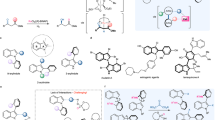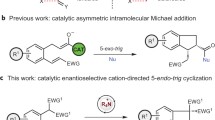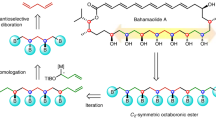Abstract
The complete mechanistic sequence of the atropo-diastereoselective ring opening reaction of configuratively unstable lactone-bridged biaryls with the chiral 2R,5R-1-lithio-2,5-dimethylpyrrolidine was calculated using the semiempirical PM3 method. It was shown that the stereochemically deciding key step of the reaction sequence is the first attack of the chiral nucleophile to the carbon atom of the lactone moiety. The diastereoselectivity of this synthetically useful and mechanistically challenging biaryl synthesis was found to originate from a dynamic kinetic resolution of the axially chiral, but configuratively unstable lactone substrates. For a further understanding of the complex stereochemical process, the geometries resulting from IRC-calculations have been visualized and are presented as an Quicktime-movie.
Similar content being viewed by others
Author information
Authors and Affiliations
Corresponding author
Electronic Supplementary Material
Rights and permissions
About this article
Cite this article
Bringmann, G., Güssregen, S., Vitt, D. et al. The Atropisomer-Selective Ring Cleavage of Helically Distorted, Configuratively Unstable Biaryl Lactones with a Chiral Metallated N-Nucleophile - the Complete PM3 Mechanistic Course and its Video Presentation. J Mol Model 4, 165–175 (1998). https://doi.org/10.1007/s0089480040165
Received:
Accepted:
Published:
Issue Date:
DOI: https://doi.org/10.1007/s0089480040165




